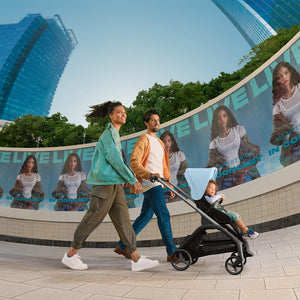
Keeping kids safe in the car: take action to prevent heatstroke
 Usually I like to keep things light here at Spilling the Beans, but this is such an important topic, and this blog from Safe Kids Worldwide has such great info that I wanted to make sure we shared it with you.
Usually I like to keep things light here at Spilling the Beans, but this is such an important topic, and this blog from Safe Kids Worldwide has such great info that I wanted to make sure we shared it with you.
Before we get started: since I know you’re busy busy busy, these are the two key tips that I gleaned from this article and other research. If you skip the rest of the article, don’t forget these important safety routines:
- ALWAYS “Look Before You Lock.” Make it a habit, whether there are kids on board or not, to look in the back seat before you lock the car, every time.
- ALWAYS leave an item you’ll need on the next leg of your trip next to your child in back – your purse, phone, briefcase, lunch, etc.
The reason why you need to do this is because leaving a child in a hot car can be deadly, and it’s a tragically common accident, caused by sheer absentmindedness. Parents are busy, parents are tired, and car seats are in the back, outside of your peripheral vision when you’re driving and exiting your car. The end result is something no one should have to experience.
These horrifying accidents happen because of how the human brain processes daily routines. Parents Magazine interviewed David Diamond, Ph.D., a neuroscientist in the psychology department at the University of South Florida, who explains how it works:
“Understanding what they did, he says, requires grasping how two very different parts of the brain work. There are the basal ganglia — the “background system” that controls our habits. “It allows us to do things without thinking about them,” Dr. Diamond says. When you’re training in sports, for example, you repeat an action over and over to fine-tune your skills. Once it’s time to compete, the action is automatic. “Your basal ganglia take over and you don’t have to think about how to bounce or shoot the ball.”
“Then there are the parts of the brain that control new information: the prefrontal cortex and hippocampus. The basal ganglia and prefrontal cortex essentially compete with each other, Dr. Diamond says. When you change up your routine and do something different, then the new details have to be processed by the hippocampus and prefrontal cortex to override the basal ganglia’s strong desire to perform actions out of habit.
“The basal ganglia play a big part in driving. “Once you’ve driven from Point A to Point B enough times, you can do it without thinking,” Dr. Diamond says. “You might not even remember the trip.” If new information enters the picture (say, your partner calls to ask you to stop at the store and buy milk), your prefrontal cortex and hippocampus have to kick into gear to incorporate it. “But it’s common to drive right past the store and come home. When your partner says, ‘Where’s the milk?’ you feel flustered because you remember the conversation, but for some reason you came home instead.” Why? Because you were on autopilot. “The basal ganglia actually suppress the prefrontal cortex and hippocampus from bringing that memory to your consciousness,” explains Dr. Diamond.
“Stress worsens this phenomenon, he adds. “It affects how our prefrontal cortex functions and makes it more likely we’ll do something out of habit.” And those factors, ultimately, are what allow otherwise responsible parents to leave their child in a car. In every hot-car death Dr. Diamond has studied, something was different about the routine that day. Jodie Edwards had to make two stops instead of her usual one. In other cases, Dad drove the baby instead of Mom or there was some other extra stress. And the basal ganglia won control.”
This is why I think the two tips I listed above are so crucial: they utilize the way your brain processes routine to ensure that you always check for the baby before you leave the car. Once again:
- “Look Before You Lock.” Make it part of your routine, every time you leave the car, to look in the back seat before you lock the car. Program your brain to make it automatic – make routine work for you!
- Always leave a key item that you need for your next destination next to your child in back: your cell phone, your purse, your briefcase, your packed lunch, or some other crucial item. That way, you’re unlikely to forget both your child and your purse – and if you do, you’ll be headed back to the car a minute later to retrieve the forgotten item.
I’m sorry to break out the grim stuff, especially on a Monday, but these tips can truly save a life. Start these new routines today, and keep those kiddos safe! And, many thanks to Chelsea Seresin, our mom on staff at Magic Beans Fairfield, for the news tip!
The post Keeping kids safe in the car: take action to prevent heatstroke appeared first on Spilling the Beans - Magic Beans.


Leave a comment